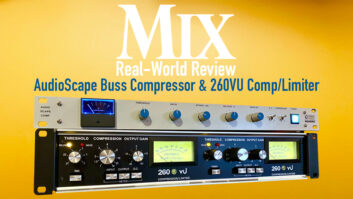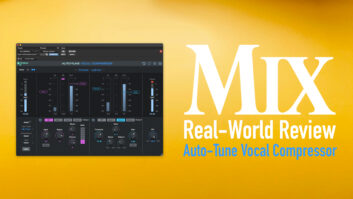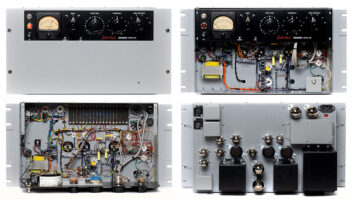
The Lindell 17X gives you onboard parallel mix control.
I’m writing this review just a week after AES 2011 in New York City where the underlying theme was “hardware and lots of it.” One of the stand-out pieces of gear at the show was the single-channel, Lindell Audio 17X FET transformer-coupled compressor/limiter. Sweden-based Lindell is best known for its high-end Reference Modular I and II three-way loudspeaker systems, so making a compressor is a new venture. Before AES, I had the 17X in session for some time and had been talking to company owner Tobias Lindell about his product. Since the beginning, I was struck by the unit’s features and sound and Lindell’s enthusiasm for audio: He’s excited about his compressor and for good reason.
INSIDE THE UNIT
The 17X is elegant in design, both inside and out. There is a beefy toroidal transformer and power supply inside, alongside Alps pots, Wima caps, gold-plated XLRs, Carnhill transformers and an intelligently designed, well-executed circuit board. The back of the unit is simple, sporting an XLR balanced input, direct out (compressed signal only) and output (post-Mix knob).
Tweaker-central is on the front of the unit, where four five-way Fender Super Switches are used for setting ratio, attack, release and sidechain highpass filter. The latter was a very handy feature that I first used on the new Retro Channel Strip that I’m reviewing for a later issue. It allows you to de-emphasize the low frequency’s effect on the compressor, letting it pass through the unit while still grabbing the mid and top-end of the signal. The ratio ranges from 4:1 to 100:1, attack and release from slow to fast, and sidechain HPF ranges from off, then 100 to 600 Hz. There are separate input and output gain controls, switchable signal lowpass and highpass filters (6dB per octave at 80 Hz and 12 kHz), switchable in/out/GR meter and a comp in switch. What’s disappointingly missing is a Link option if you wanted to strap two units together.
IT CRUSHED ME
I first heard the Lindell 17X on a kick drum recorded with a Shure Beta 52 placed inside the front head, about four inches from the beater. I set the unit for a slower attack and fast release, and it gave me that FET compressor grab that I expected, letting the initial attack bloom and then deftly grab the signal, pulling it back then releasing, ready for the next peak. I then set the sidechain HPF at 100 and then 200 Hz, which let the “boom” of the kick come through and grabbed the beater hit, bringing it up in the mix—perfect. Combined with an AKG D-112 placed outside the front head was just the ticket for that extreme chest-thumping kick with a perfect attack that worked well with the bass.

The 17X also shined when used on a snare drum recorded with a Shure SM57 on top and one on the bottom. I strapped the 17X across the insert of the top mic channel on an SSL 4000 Series console and set the ratio at the lowest setting (4:1). I was looking for that FET pop on the snare drum, which the 17X did very well. I was able to fine tune the FET’s effect on the signal by playing with the attack and release until I got it where the compressor wasn’t pumping, but was consistently grabbing the signal without being that apparent. In a later session, I used the 17X on the snare bottom mic, allowing me to bring the snap of the snare into the blend while leaving the snare-top signal fairly dark and prominent in the midrange. In this application, I kicked in the 80Hz HPF, which de-accentuated the kick drum in the signal, and I also played with the sidechain HPF so that the low frequency produced below the snare wouldn’t effect the operation of the detector circuit.
Next, I heard the Lindell 17X used on a guitar track. I smashed the signal at 100:1 (you’ve just got to go there for fun), but it was not right for this application. However, it did work well on a later mix. In this case, I backed the ratio down to 12:1, crushing the signal more than I needed but it still sounded great. This is where the onboard mix control comes in handy. I balanced the direct vs. compressed signal (which was perfect), bringing that certain something that a compressed signal does to the blend without being overpowering.
The Mix feature is one of the best things about the 17X. I often mix using parallel compression both inside and outside the DAW, where I mix signals “into” a compressor rather than using it in a serial fashion. This requires sending your signal from a channel via a send to an auxiliary input where you have the compressor patched across the channel. Having all of this inside the 17X makes it a lot easier to just patch the unit across your signal’s insert and then control the blend from the unit.
I next used the 17X on a hand-percussion track recorded with a Voodoo Electronics VR1 passive ribbon mic. The 17X was perfect for this application as it tamed the transient peaks but still let the track sound open yet consistent, especially when I used the Mix control to blend in the uncompressed signal. With the mix set about 60:40 compressed to uncompressed signal, this was perfect for keeping the track up in the mix without annoying peaks.
DOES SHE GO?
Aside from missing the ability to couple two units during use, then loving the brilliant design, I had other mixed feelings about the physical box. For instance, the first unit I got for review was dead. After a quick swap, I received a second unit and quickly noticed that there was something loose inside. After popping the lid, I saw the toroidal power supply transformer was moving around and was missing its lockdown screw, which wasn’t floating in the box, forgotten in production. Also, the unit’s plastic covers for the end of the five-way switches easily came off during use; a little Loctite would go a long way to remedy this. Lastly, the gain-reduction setting on the meter acted as I’d expect, but the input/output was down almost -10 dB from what I was sending into the unit when tested with my Audio Precision APx525 audio analyzer.
Although these gripes seem substantial, they are outweighed by the sound and fun factor when using 17X. The unit has its own personality and is a blast to take from 0 to 60 just to see what you get. I absolutely flattened some guitar tracks at 100:1 just for fun and ended up using it in parallel in the mix. You can also play with the sidechain HPF to get additional sonic loveliness and versatility. Add in the Mix control, sidechain filter, HPF and LPF, and you’ve got a compressor that’s the tops—as long as you can get past some assembly quirks.
Kevin Becka is
Mix
’s technical editor and is in the process of building his own mix studio.

Click on the Product Summary box above to view the Lindell 17X product page.
Lindell 17X Demo Video







